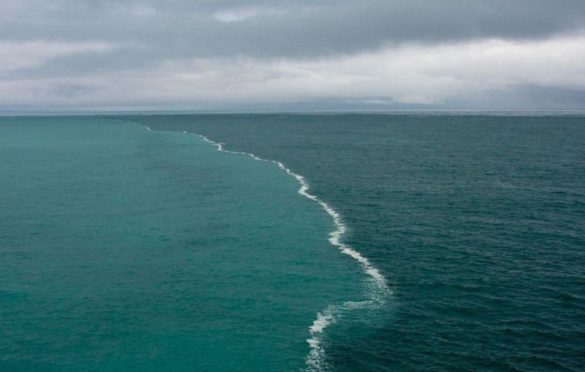The Amazing Phenomenon Of Where Two Oceans Meet But Don’t Mix

Introduction:
The mesmerizing phenomenon of two oceans meeting without mixing has fascinated scientists and travelers for centuries. This rare natural occurrence occurs at several locations around the world and is a captivating sight to witness. In this article, we will delve into the science behind this remarkable event, explore some of the most famous spots where this happens, and answer common questions about this fascinating phenomenon.
The Science Behind the Phenomenon
Surface Tension and Density – The Key Players
At the heart of this amazing phenomenon lie the concepts of surface tension and density. Surface tension is the force that causes the molecules at the surface of a liquid to stick together, creating a “skin” on the water’s surface. On the other hand, density refers to the mass of a substance per unit volume. When two bodies of water with different densities meet, their distinct properties lead to the formation of a visible boundary.
Salinity Differences and Thermal Gradients
Another factor influencing the phenomenon is the variance in salinity and temperature between the two oceans. The meeting of two bodies of water with different salinity levels can lead to stratification, where one layer remains on top of the other without mixing. Additionally, temperature gradients can contribute to the formation of distinct boundaries between the oceans.
Incredible Locations of Oceanic Meetings
The Gulf of Alaska
One of the most famous locations where this phenomenon occurs is in the Gulf of Alaska. Here, the Gulf’s waters, which are rich in glacial sediments and have a milky appearance, meet the deep blue waters of the Pacific Ocean. The stark contrast in color between the two bodies of water creates a breathtaking sight.
The Convergence of the Black and Aegean Seas
The meeting point of the Black Sea and the Aegean Sea is another awe-inspiring example of this phenomenon. The Black Sea’s waters have a lower salinity compared to the saltier Aegean Sea, causing them to remain separated due to density differences. Witnessing this natural boundary is an unforgettable experience for those who visit the area.
The Enigmatic Waters of the Baltic and North Seas
The Baltic Sea, with its lower salinity and unique chemical composition, meets the saltier North Sea in a visible demarcation. This event is particularly intriguing as it demonstrates the delicate balance of nature and the complex interplay of different oceanic properties.
Frequently Asked Questions
Can You Cross the Boundary Where Two Oceans Meet?
While the visual boundary between the two oceans may appear solid, it’s essential to understand that it is not an impenetrable wall. It is possible to sail or swim through the meeting point, but you may experience a noticeable shift in water properties as you cross from one side to the other.
Does This Phenomenon Happen in All Oceans?
No, this phenomenon is not widespread, as it requires specific conditions of density, salinity, and temperature differences. As a result, you can only witness this mesmerizing event at certain locations around the world.
Are There Any Ecological Implications?
The meeting of two oceans can have ecological implications. For instance, nutrient-rich waters can enrich the surrounding marine life, attracting a diverse array of organisms. However, it is crucial to monitor these areas to ensure that human activities do not disturb the delicate balance of these ecosystems.
Conclusion
The amazing phenomenon of two oceans meeting without mixing is a natural wonder that never fails to captivate our imagination. It serves as a reminder of the complexity and beauty of our planet’s natural processes. From the Gulf of Alaska to the Black and Aegean Seas, these oceanic meetings leave us in awe of the forces of nature. As we continue to explore and appreciate such remarkable occurrences, let us also remember the importance of preserving and protecting our oceans for future generations to cherish.

